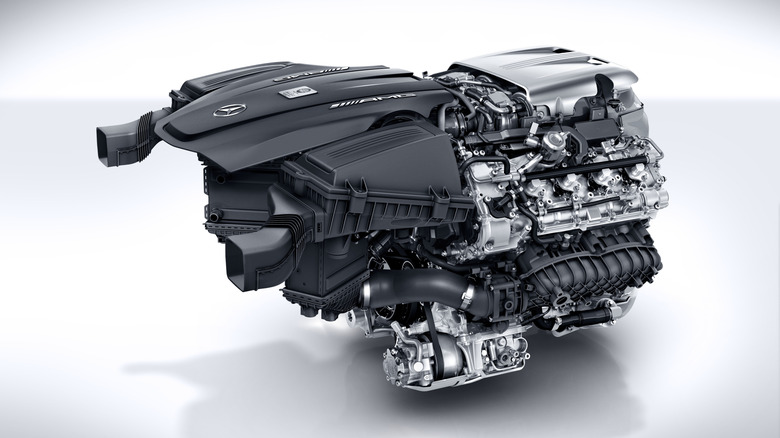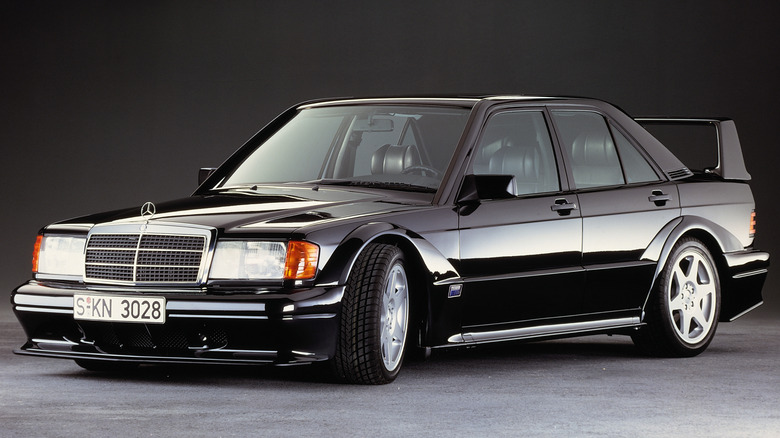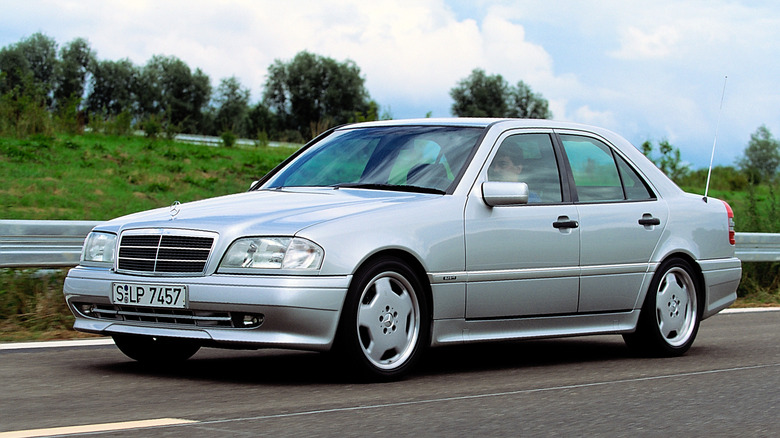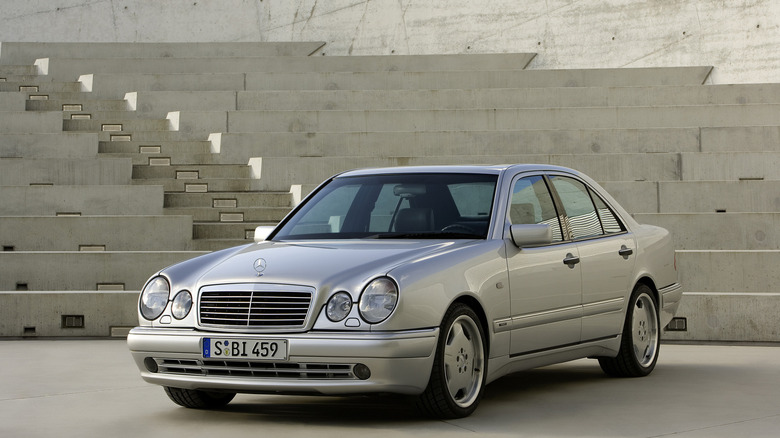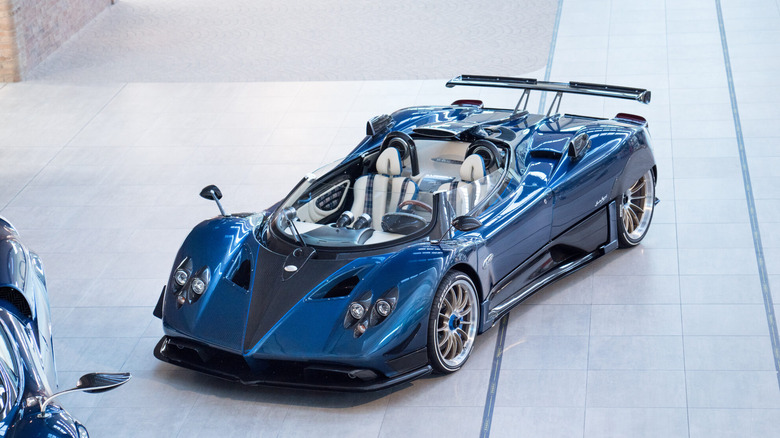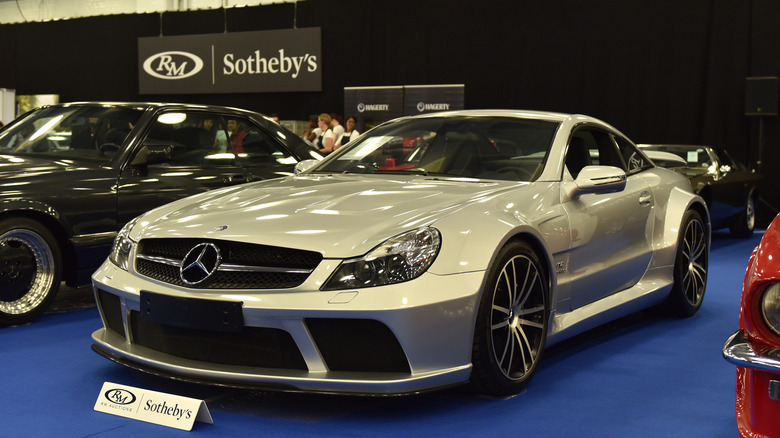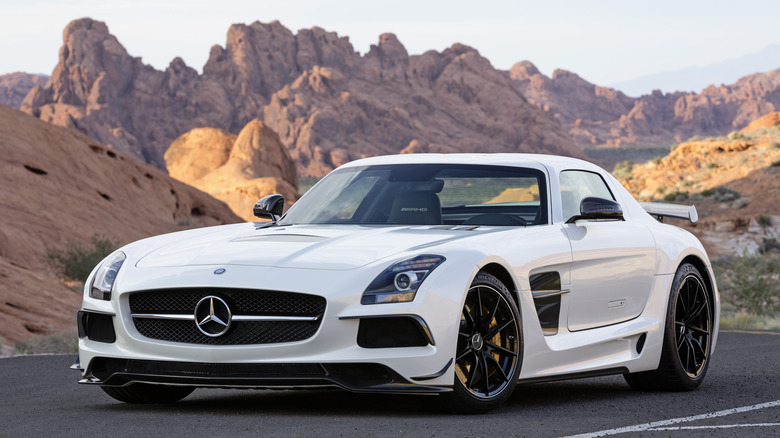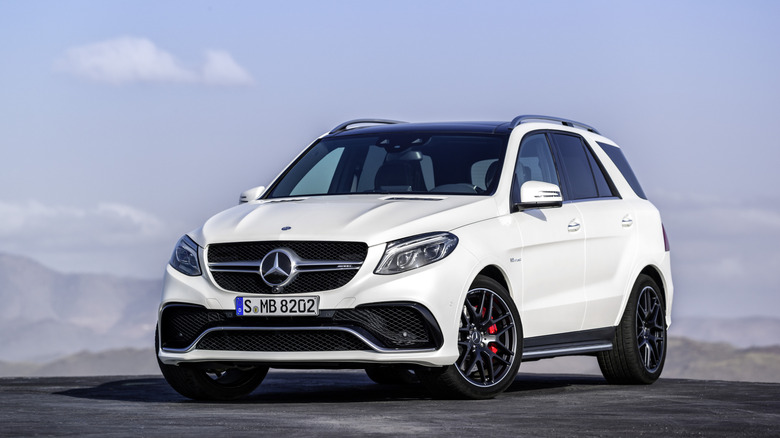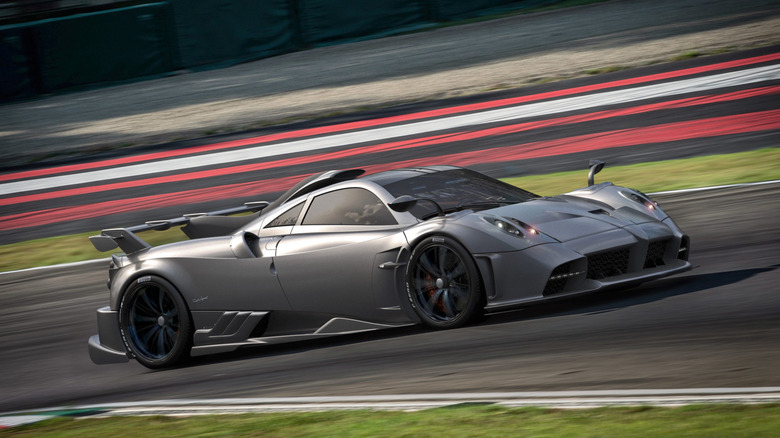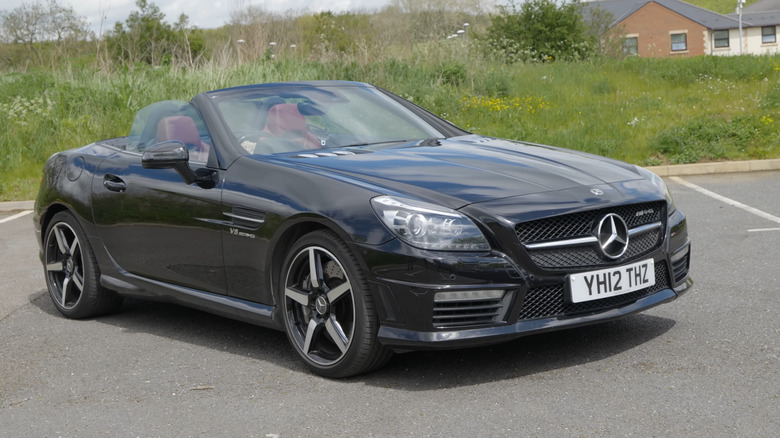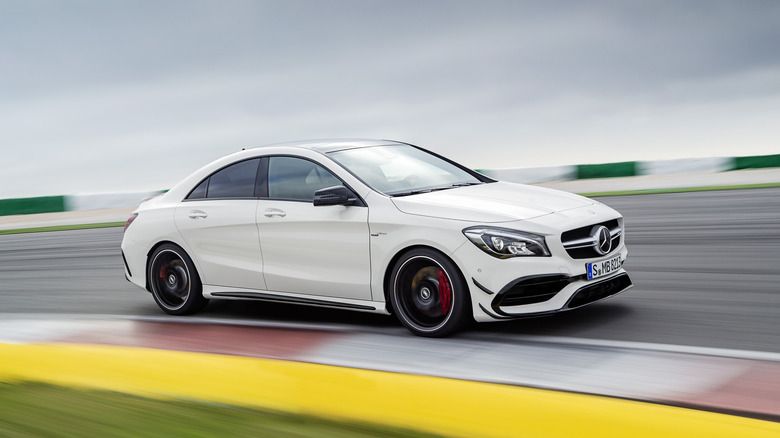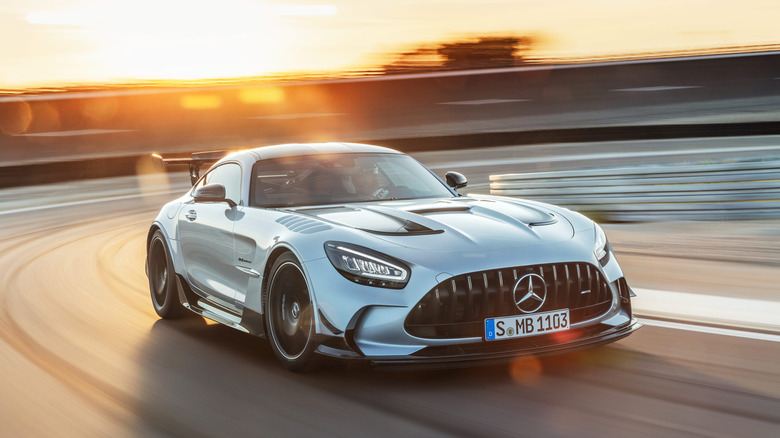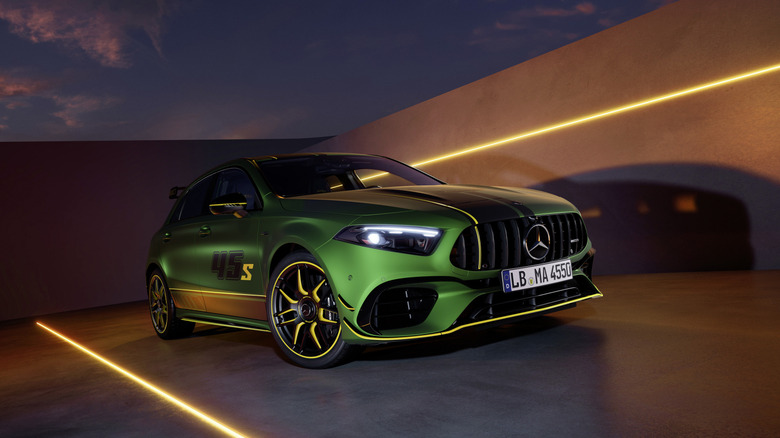12 Of The Greatest Mercedes AMG Engines Ever Made
Mercedes-Benz has been part of the highest echelons of racing and produced great performance vehicles ever since its inception. From its 1920s success with the SSK to launching one of the best German cars in history with the 300 SL Gullwing, Mercedes-Benz was synonymous with speed. However, after the 1955 Le Mans disaster, where a Mercedes car crashed and killed 77 people, the brand quit racing for a few decades and focused its efforts on building luxury machines.
However, two of Merc's engineers, Hans Werner Aufrecht and Erhard Melcher weren't content with the status quo. So, in 1967, they left Daimler-Benz and established their own company — AMG. In 1976, they moved to Affalterbach, where their company tuned existing Mercedes-Benz engines to help them win races and dominate the performance car segment once again. AMG was so good, in fact, that Mercedes-Benz eventually started collaborating with and then bought the tuning firm in 1999. Since then, AMG has been giving us some of the wildest internal combustion engines, and here, I'll let you know more about them.
I've been writing about, testing, and reviewing cars for over 15 years — what follows is a list of what I consider to be 12 of the greatest Mercedes AMG engines ever made. As each has a unique reason why it's on this list, I went with a chronological order. Hope you enjoy it!
M102 Cosworth 2.5-liter Inline-4 with AMG Power Pack (1988 to 1991)
Mercedes-Benz was feeling the heat from its fiercest rivals in the 1980s. Audi was dominating motorsport with its AWD Quattro machines, while BMW made touring car racing a one-sided affair. Merc's answer was the 190E 2.3-16 Cosworth Group A racecar. With a special 2.3-liter Cosworth-enhanced engine, the 190E couldn't beat the competition, but it broke the 50,000-km (31,069 miles) record in 1983, covering the distance in just 201 hours, 39 minutes, and 43 seconds.
Still, Merc's ultimate goal was to win races, and in 1986, it gave privateers in the 1986 DTM championship an improved 190E 2.5-16. Most notably, Helmut Marko's "Team Marko," which collaborated with AMG, finished second in the championship. In 1988, though, Mercedes entered DTM with a factory team, aided by AMG's expertise. The tuning firm massaged the naturally aspirated 2.5-liter engine to 315 hp in the Evolution I, and 370 hp in the Evolution II racecar. The latter finally snatched the DTM title in 1992, ending years of BMW domination.
Crucially for enthusiasts, Mercedes and AMG produced 502 homologation variants. Some of the early Evolution I examples were available with the AMG Power Pack, giving the engine 225 hp at 7,200 rpm — a 30-hp increase. The pack included new cams, a larger throttle body, and a new fuel management system. In the 190E 2.5-16 Evolution II, the AMG Power Pack became standard, resulting in 235 hp at 7,200 rpm. So, while the 2.5-liter wasn't an AMG-designed engine, but it definitely showed the firm's tuning prowess. It was also a sign of even greater things to come from Affalterbach.
M104 AMG 3.6-liter Inline-6 (1993 to 1997)
AMG's work on the 190E 2.5-16 was commendable, but it wasn't until 1993 that the tuning firm started doing some serious work for Mercedes-Benz. That year, AMG entered into a joint venture with the automaker, and its first project was giving the 190E's successor more verve. So, the C36 AMG was born, based on the W202 chassis C-Class.
The C36 AMG was no homologation special like its predecessor, but it did have two extra cylinders. Its name suggested a 3.6-liter capacity — yup, back in the day Merc's nomenclature meant something. The configuration was inline-six, the same as its fiercest rival, the BMW M3 E36. During that time, AMG wasn't developing engines, so this meant it had to rework the existing inline-six from the C280. AMG did a great job, though, boosting it to 268 hp (+74 hp) and 280 lb-ft of torque for the U.S. market.
To achieve those figures, AMG bored the engine by 1.1 mm and used larger forged aluminum pistons. Moreover, the compression ratio was raised from 10.0:1 to 10.5:1, and the stiffer crankshaft from the C350 turbodiesel engine was used to increase the engine stroke. This added a significant displacement bump of 0.8 liters, resulting in a 0-60 mph time of just six seconds and a top speed of 155 mph.
Those are some impressive figures, especially when you consider Mercedes-Benz and AMG only offered a four-speed automatic transmission. While not one of AMG's brightest moments, the heavily reworked engine was a sign of great things to come from the tuning firm.
M113/M113K AMG 5.4-liter V8 (1997 to 2011)
After meddling with Merc's inline-four and inline-six engines, AMG shifted its focus to the company's V8 machines. We are glad it did because it gave us the W202 C43 AMG in 1997, but the real world-beater was its tuned M113 engine. This 5.4-liter V8 has found its way into numerous Mercedes-Benz performance vehicles with the 55 designation, like the first-gen E55 AMG.
AMG took Merc's 5.0-liter M113 V8, added 400cc to it, new cams, and free-flow exhaust, resulting in 349 hp and 391 lb-ft of torque. As great as the first E55 AMG was, it was only the beginning. For the next generation model, AMG equipped the engine with a 2.1-liter Lysholm-type supercharger, which boosted it to 469 hp and 516 lb-ft of torque. Thus, the 2003 E55 AMG could reach 60 mph in just 4.5 seconds, despite its older five-speed automatic. Crucially, the M113K is one of the most reliable V8 engines ever made, even in its supercharged form!
The supercharged M113K engine also found its way into the S55 AMG, but it was the SL55 where things got really interesting. With 510 hp and 531 lb-ft of torque, the M113K pushed the roadster to 60 mph in 4.3 seconds, putting it firmly in supercar territory. AMG wasn't done, though, and as a last hoorah, made the M113K-powered CLK DTM AMG — a 582 hp race car for the road with an electronically-limited top speed of 199 mph!
M297 AMG 6.9-liter & 7.3-ilter V12 (1997 to 2016)
Ever heard of the Mercedes CLK GTR Strassenversion? It's one of the most intense homologation specials in history, with a racecar-like aero and a fire-breathing AMG-tuned engine in the middle. The 6.9-liter V12 was a fully rebuilt version of Merc's M120 6.0-liter V12 engine, but after AMG's engineers had done their magic, it made 600 hp and 572 lb-ft of torque. The new unit was so different than the original that AMG even applied a different codename — M297.
The M297 was so impressive, in fact, that a certain Horacio Pagani knocked on AMG's door, asking the tuning firm to make a V12 engine for his supercars. So, in 2001, an even more intense 7.3-liter version appeared in the Pagani Zonda producing 547 hp. Not impressed? Power was raised gradually in subsequent years, with the 2009 Zonda Cinque receiving a 668 hp tune of the engine. Still naturally aspirated, this M297 catapulted the exquisite supercar to 62 mph in 3.4 seconds and to a top speed of 217 mph.
By now you'd think AMG was finished. However, in 2017, the tuning firm built one of its most impressive engines ever, tuning the 7.3-liter V12 to a staggering 778 hp and 627 lb-ft of torque, which is still competitive with today's hypercars.
M275/M279 AMG 6.0-liter Biturbo V12 (2004 to 2018)
The M297 had impressive torque, but if you wanted Earth-shattering, tire-shredding torque, turbochargers were always the answer. AMG, of course, has such an engine in its portfolio –- the M275 AMG. Built over the regular M295 5.5-liter unit, AMG's monster was not only enlarged to 6.0 liters, but it also had larger turbochargers. The usual valve job, reinforced pistons, and larger fuel injectors were also part of AMG's tune.
Excessive? There is no such word in AMG's dictionary. There are some crazy numbers, though, with the CL 65 AMG and S 65 AMG packing 603 hp and a whopping 738 lb-ft of M295 AMG torque goodness. However, true AMG enthusiasts will tell you that the lightweight SL 65 AMG Black Series was the best way to enjoy the engine. There, it made 661 hp and propelled the sharp coupe to 62 mph in just 3.8 seconds. Torque stayed the same at 738 lb-ft, but that was only because the five-speed automatic couldn't handle more.
From 2012, though, AMG developed the extensively reworked M279, fully in-house. With forged pistons and a crankshaft made from high-grade quenched steel, even more, aggressive cams, and hollow-stem sodium outlet valves, the M297 was good for up to 621 hp in the 2018 SL 65 AMG. Crucially, it was paired with Merc's seven-speed automatic, rather than the aging five-speed one.
M156/M159 AMG 6.2-liter V8 (2006 to 2014)
AMG's M156 6.2-liter naturally aspirated V8 is almost mythical by this point. To begin with, it's the first one built from the ground up by AMG. It also powered some outstanding performance machines from 2006 to 2014, like the E 63 AMG and C 63 AMG, ranging from 451 hp to 518 hp. Being a naturally aspirated unit, it pulls anywhere in the rev range, able to burn the rear tires at any given moment. More than anything, though, it's one of the best-sounding V8s, producing a thunderous noise that can be heard from a few blocks away.
AMG used everything from its racing arsenal to make it perform as well as it did. Forged steel alloy crankshaft and heavy-duty connecting rods moved cast hypereutectic pistons, replaced by even stiffer Mahle forged pistons in the P31 performance package. The 32-valve DOHC engine head featured variable valve timing to increase power and efficiency, and the M156 was exclusively equipped with dry sump lubrication in all models.
AMG's 6.2-liter masterpiece culminated with the M159, a special version of the engine made specifically for the SLS AMG. There, it made 583 hp and 479 lb-ft of torque, allowing the gullwing supercar a brisk 0-62 mph time of just 3.7 seconds.
M157 AMG 5.5-liter Biturbo V8 (2011 to 2017)
The M156 was a great engine, but it wasn't going to cut it in the horsepower war era. So for its next creation, the M157, AMG went back to turbocharging. Only this time, efficiency was also part of the reason, with the new 5.5-liter Biturbo V8 consuming 25% less fuel than the M156. Initially, the engine produced 536 hp and 590 lb-ft of torque, though the Performance Package bumped those figures to 563 hp and a whopping 664 lb-ft. In the 2014 CLS 63s, the M157 was boosted even further to 577 hp, though with a lower 590 lb-ft torque output.
Unlike the M156, though, the M157 was based on an existing Mercedes-Benz creation — the 4.7-liter Biturbo M278 powertrain. AMG bored and stroked the engine to reach 5.5 liters of capacity, installed forged internals, piston rings with a diamond-like coating and direct injection. The M157 was also very compact and could fit in most of Merc's RWD cars, except the smallest C-Class. Still, it also found its way into the brand's performance SUVs, like the third-gen GLE 63 AMG. Crucially, despite the forced induction bits, the M157 still sounded angry and brawny.
M158 AMG 6.0-liter Biturbo V12 (2011 to 2022)
The M158 was AMG's second engine built for Horacio Pagani's quirky supercars. This time, the 6.0-liter Biturbo V12 was exclusively developed for the Huayra supercar, gracing it with 764 hp and an astonishing 738 lb-ft of torque. However, AMG and Pagani weren't content with that figure and for the Huayra Imola, bumped the output to 827 hp and 813 lb-ft of torque.
All of that monstrous power was sent directly to the rear wheels through a seven-speed single-clutch transmission, and the Imola weighed only 2,747 pounds. More importantly, Pagani and AMG focused on the driving experience. Turbocharged powertrains inevitably sound more muted than naturally aspirated ones, so Pagani designed a special six-pipe titanium exhaust with a ceramic coating applied using a sophisticated plasma-fusion system. Of course, the state-of-the-art exhaust system wasn't only there to improve the aural sensation but also to reduce weight and improve heat dissipation.
M152 AMG 5.5-liter V8 (2012 to 2015)
AMG didn't leave its fans without a high-revving V8 after the 6.2-liter M156 engine, and built a naturally aspirated version of the bi-turbo M157 engine for the SLK 55 AMG. The 5.5-liter V8 produced 415 hp and 398 lb-ft of torque — a far cry from the M157's 536 hp. Still, the SLK 55 AMG was a much lighter car, weighing 3,384 pounds. So, it reached 60 mph in a brisk 4.4 seconds and with the AMG Handling package it was able to hit 174 mph.
Although the M152 is a bit forgotten today, it's a great engine in its own right. For starters, it sounds angrier than its boosted relative. It is also a technologically advanced unit, with direct injection, cylinder shutdown, and a start/stop system for improved fuel economy. AMG also increased the compression ratio to 12.6:1 and gave the M152 a 7,200 rpm redline. That fact, and its rarity, might make the M152 engine a future classic.
M133 AMG 2.0-liter Turbocharged Inline-4 (2013 to 2019)
A four-cylinder AMG engine wasn't a thing for over two decades. Even then, AMG only perfected Cosworth's already outstanding engine. Still, Merc's compact cars also needed an AMG treatment to compete with their Audi and BMW rivals. So, the tuning firm developed the M133 — a 2.0-liter turbocharged unit gracing the A45 and CLA 45 AMG rockets.
With 355 hp, the M133 was the most powerful 2.0-liter engine in 2013. However, it was perhaps even more impressive in other areas. Notably, the whole unit weighed only 326 pounds and could rev to 6,700 rpm. The latter is an impressive figure considering the M133 was a heavily boosted engine (26 psi), and crucially, gave character to Merc's pocket rockets. Sure, it didn't sound as good as an AMG V8, but its racecar-like sonic quality was still pleasing to the ears. Crackles were part of the experience, too.
AMG used only its most sophisticated ingredients to achieve that much power from the tiny engine. So, a twin-scroll turbocharger, direct injection, and a specially developed performance exhaust system were all present. Moreover, AMG paired the M133 exclusively with the AMG-SPEEDSHIFT dual-clutch transmission, resulting in lightning-quick gear changes. The result was Earth-shattering — the 2013 AMG 45 reached 62 mph in just 4.6 seconds, dispersing the engine's power to all four wheels.
M178 AMG 4.0-liter Biturbo V8 (2015 to Present)
The M178 is AMG's most advanced V8 engine ever made. However, it wasn't welcomed with open arms, as enthusiasts were still weeping over the loss of the naturally aspirated V8. However, from today's perspective, AMG's move to a smaller bi-turbo engine was the right one.
With its two BorgWarner turbochargers sitting between the cylinder banks (hot vee configuration), the M178 promises quick responses — great news for naturally aspirated enthusiasts. It's even the first-ever hot vee engine with a dry sump lubrication system. Of course, you know that AMG is all about power, and initially, the 4.0-liter Biturbo V8 made 503 hp and 479 lb-ft of torque. Not impressed? In the Mercedes-AMG GT 63 S 4-Door, AMG boosted the M178 to 630 hp, allowing the sleek four-door coupe to reach 196 mph. Want more? The 2023 AMG GT Black Series makes a whopping 720 hp and 590 lb-ft of torque. Sheesh.
The engine was also equipped with exotic features like a sand-casted aluminum crankcase and a cylinder bore made with NANOSLIDE technology for unmatched hardness. AMG even treated the cylinder liners after they were bolted in place to reduce friction, in a process called spectacle honing. The liners hosted forged aluminum pistons and low-friction piston rings, and on top, were accompanied by cylinder heads with zirconium alloy for higher temperature resistance. Even so, AMG used an air/water intercooler with a separate low-temperature water circuit to cool the air before it entered the chamber for more efficient combustion.
M139 AMG 2.0-liter Turbocharged Inline-4 (2019 to Present)
In 2019, AMG continued perfecting its four-cylinder formula with the M139. The brand-new motor has extraordinary amounts of power, with the higher output variant producing 416 hp and 369 lb-ft of torque. Now accompanied by an eight-speed dual-clutch transmission, the M139 propels the latest A 45 S AMG to 62 mph in just 3.9 seconds and up to a top speed of 168 mph. The more amazing part is that AMG kept the redline at 7,200 rpm, keeping high-rpm enthusiasts satisfied.
However, AMG made an even brawnier version of the M139 for the latest C 63 S E Performance, where it produces a staggering 442 hp. The most impressive part is that it is accompanied by a plug-in hybrid system, resulting in an overall output of an astonishing 671 hp. As a result, it arrives at the 60-mph mark in 3.3 seconds and can go 174 mph.
Being the latest engine from AMG, the M139 is its most advanced. For the first time, AMG used two-stage fuel injection, which combined direct and port injection for more efficient combustion. Furthermore, the exhaust valves were made larger to increase airflow, and the cylinder liners made with NANOSLIDE technology from the M178 were used, too. However, AMG went a step further and also minimized friction in the turbocharger shafts by employing roller bearings. Heck, it's even hand-built at AMG's proving grounds in Affalterbach!
